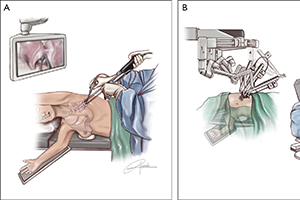Uniportal robotic versus thoracoscopic assisted surgery: a propensity score-matched analysis of the initial 100 cases
Abstract
Background: Minimally invasive surgery (MIS) is becoming the standard of care for anatomic lung resections. The advantages of the uniportal approach compared to the conventional multiple incision approach, multiportal video-assisted thoracic surgery (mVATS) and multiportal robotic-assisted thoracic surgery (mRATS), have been previously described. However, no research studies comparing early outcomes between uniportal video-assisted thoracic surgery (uVATS) and uniportal robotic-assisted thoracic surgery (uRATS) have been reported.
Methods: Anatomic lung resections performed by uVATS and uRATS from August 2010 to October 2022 were enrolled. Early outcomes were compared after propensity score-matched (PSM) analysis by applying a multivariable logistic regression model including gender, age, smoking habit, forced expiratory volume in the first second (FEV1), cardiovascular risk factors (CVRF), pleural adhesions and tumor size.
Results: A total of 200 patients who underwent anatomic lung resections by the same surgeon were recruited in this study, including the initial 100 uVATS patients and the initial 100 uRATS patients. After PSM analysis, each group included 68 patients. The comparison of the two groups showed no significant differences according to the TNM stage in patients with lung cancer, surgical time, intraoperative complications, conversion, number of nodal stations explored, opioid usage, prolonged air leak, length of intensive care unit (ICU) and hospitalization, reintervention and mortality. However, there were significant differences concerning the histology and type of resection (anatomic segmentectomies, the proportion of complex segmentectomies and the sleeve technique were significantly higher in the uRATS group), number of resected lymph nodes (significantly higher in the uRATS group), postoperative complications and duration of chest drain (significantly lower in the uRATS group).
Conclusions: Judging from the short-term outcomes, our results confirm the safety, feasibility and efficacy of uRATS as a new minimally invasive technique that combines the benefits of the uniportal method and robotic systems.
Cover






